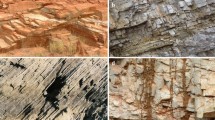Abstract.
Misorientation analysis quantifies microstructural features in tectonites, metamorphic and igneous rocks, and allows hypotheses on their formation to be tested. The misorientation between two lattices can be expressed by a rotation axis and rotation angle. For lattices with symmetry, it is conventional to take the minimum angle that enables one lattice to be rotated into the other. For a group of lattice measurements two types of misorientation distribution can be calculated. Selecting random pairs of grains gives the random-pair misorientation distribution. Selecting neighbouring pairs gives the neighbour-pair misorientation distribution. The forms of both distributions are visualised using histograms or cumulative frequency diagrams. They are strongly influenced by any overall crystallographic preferred orientation and by intrinsic crystal symmetry. In many rocks, the random-pair misorientation distribution and neighbour-pair misorientation distribution are statistically significantly different (quantified using the Kolmogorov–Smirnov test). Differences between the random-pair misorientation distribution and neighbour-pair misorientation distribution imply that adjacent grains have physically interacted or are inherited from a precursor microstructure. Interactions include (1) reduction in surface energy by lattice alignment. We show this may have occurred in garnet clusters in schist, and olivine in a cumulate. It is well-known in metals and may be a common geological process. (2) Nucleation, where those nuclei have influenced the orientation of adjacent nuclei. (3) Mechanical rotations of facetted grains in compacting crystal mushes, so that faces become parallel. (4) Growth twinning. Inheritance includes (1) subgrain rotation recrystallisation in tectonites deforming by crystal plastic processes. (2) Mechanical and transformation-related twinning. (3) Domainal microstructures, e.g. where grains have formed from a few large original grains, may give rise to spurious correlations when the orientation data cover more than one domain. With this proviso, misorientation analysis can be used to investigate many important microstructural processes.
Similar content being viewed by others
Author information
Authors and Affiliations
Additional information
Electronic Publication
Rights and permissions
About this article
Cite this article
Wheeler, .J., Prior, .D., Jiang, .Z. et al. The petrological significance of misorientations between grains. Contrib Mineral Petrol 141, 109–124 (2001). https://doi.org/10.1007/s004100000225
Received:
Accepted:
Issue Date:
DOI: https://doi.org/10.1007/s004100000225




